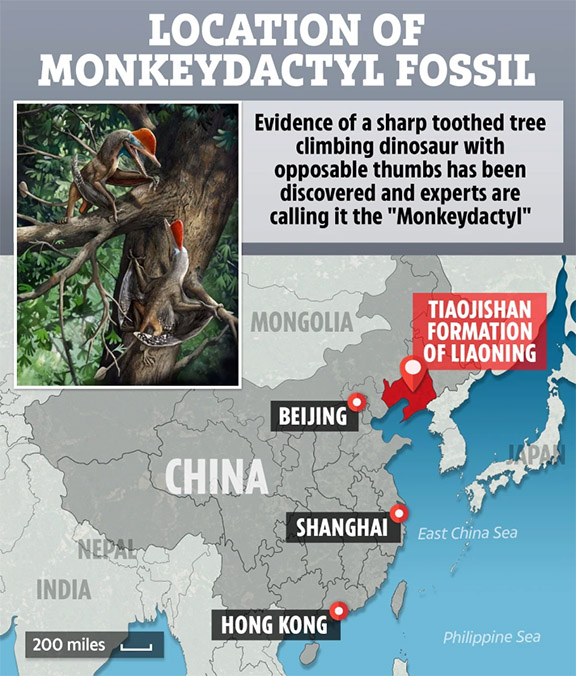Science & Technology
Monkeydactyl: Pterosaur Species
- 16 Apr 2021
- 4 min read
Why in News
The new pterosaur fossil was discovered in the Tiaojishan Formation of Liaoning, China, and is thought to be 160 million years old.
- It has been named Kunpengopterus antipollicatus, also dubbed “Monkeydactyl”.
Tiaojishan Formation
- Geographically, the Tiaojishan Formation is widely distributed in western Liaoning Province and the neighboring northern Hebei Province (China).
- This formation is lithologically composed of intermediate lava and pyroclastic rocks, interlayered with basic volcanic rocks and sedimentary deposits.
- It contains abundant and well-preserved fossil plants, including leaves, seeds and fruits, permineralized rhizomes and wood.
Key Points
- About Pterosaurs:
- The pterosaur species were reptiles, close cousins of dinosaurs and the first animals after insects to evolve powered flight.
- They evolved into various species, while some were as large as an F-16 fighter jet, others were as small as paper airplanes.
- They flourished during all periods (Triassic, Jurassic, and Cretaceous) of the Mesozoic Era (252.2 million to 66 million years ago).
- About the Monkeydactyl Fossil (Kunpengopterus antipollicatus):
- “Antipollicatus” in ancient Greek means “opposite thumbs”, and it was attached to the name because the researchers’ findings could be the first discovery of a pterosaur with an opposed thumb.
- It could likely be the earliest-known instance of the limb.
- It is far older than the one identified in 2019.
- Paleontologists had identified that species as a pterosaur that lived over 77 million years ago in what is Western Canada today.
- Named Cryodrakon boreas, it was believed to be one of the largest flying animals, which “flew over the heads of dinosaurs”, with a wingspan of over 10 metres.
- “Antipollicatus” in ancient Greek means “opposite thumbs”, and it was attached to the name because the researchers’ findings could be the first discovery of a pterosaur with an opposed thumb.
- Opposability of the Thumb:
- About:
- Opposability of the thumb is defined as being able to “simultaneously flex, abduct and medially rotate the thumb” in a way that one is able to bring the tip of the thumb to touch the tips of the other fingers.
- Along with humans, some ancient monkeys and apes also had opposable thumbs.
- Humans, however, have a relatively longer and distally placed thumb, and larger thumb muscles.
- This means that humans’ tip-to-tip precision grip when holding smaller objects is superior to non-human primates. This is the reason that humans are able to hold a pen, unscrew an earring stopper, or put a thread through a needle hole.
- Monkeydactyl and Opposability of the Thumb:
- The research team scanned the fossil of K. antipollicatus using micro-computed tomography (micro-CT), a technique making use of X-ray to image an object.
- By studying its forelimb morphology and musculature, they suggest that K. antipollicatus could have used its hand for grasping, which is likely an adaptation for arboreal life (living in trees).
- The grasping hands of primates developed as a result of their life in the trees — an opposable thumb made it easier for the common ancestor of all primates to cling on to tree branches.
- About:







